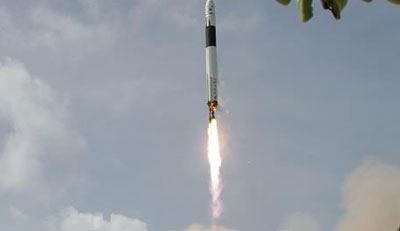First flight factsby Wayne Eleazer
|
| In the beginning, essentially no one knew how to build a successful space booster. This is in contrast to today, in which merely the vast majority of people don’t have clue how to do so. |
Then there is the problem of defining a failure. A launch failure can range from the explosion of a booster on its pad, destroying not only the booster but also the payload and the launch facility, to a payload arriving in operating condition in a less than optimum orbit. Either case represents a failure to get the ultimate job done properly, a “mission failure,” but the on-pad explosion situation also is of special interest because it is a case where a hazard was presented to people on the ground. So is a failure truly a “boom” or just a bit of a “bust?”
Considering all kinds of space launches and all kinds of mission failures since 1980—a total of a little over 2,500 launches—the overall probability of a mission failure, worldwide, is about 6%. About half of those failures, around 3% of total launches, are cases where no orbit of any kind was achieved. And by the way, a very small number of the 2,500+ total, less than two dozen, were deliberately planned suborbital launches that utilized space launch hardware; the ones of that type that worked the way they should have are not considered to be failures.
Space launch failures certainly are not considered to be normal, but they are still distressingly common. And it is not getting better either: just since the end of March 2002, mission failures actually have increased a bit over the overall average, up to around 7% of the total.
New vehicles
So much for the big picture. The issue at hand is how often do new vehicles blow it on their first few tries. Taking a more detailed look at just truly new vehicles that launched during the period of January 1, 1980 to March 31, 2002, we see that there were 29 first flight launches worldwide and 14 that resulted in a mission failure. That equates to a Probability of Failure of 48%, eight times higher than the overall average.
That number is by itself startling, but when you look at more details things get much more informative. Taking a look just at launches by experienced companies, you find that even the old hands have a distressingly high Pf: 33% of their first launches result in a mission failure. Surprisingly, their second launches are even a bit worse, with a 38% probability of not doing what the payload needs.
Then there are the novice outfits, the beginners with new vehicles. Their first flights are marked by a 73% probability of a mission failure—over twice as bad as the experienced companies. For their second flights they manage to go from horrible to only terrible, with a 57% probability of failure. Looked at another way, novice companies launching new rockets have nearly a one hundred percent probability of getting a mission failure sometime in the first two launches.
| First flights have always been white knuckle events for everyone involved, and with good reason. |
Things get much better after the second launch, with the novice firms doing about as well on their third launch (33% failures) as the experienced companies did on their first new launch. However, this phenomenon appears to have as much to do with many new firms not surviving their second launch—and failure—as it does their learning from their mistakes.
Examining the overall numbers for all new vehicles again, from both experienced and novice firms, the data shows that for at least the first eight launches, the Pf never drops to less than twice the average failure probability of 6%, and for much of that time it is three or four times the overall average.
The grim conclusion
New vehicles fail much more often than do ones with lots of launches. New vehicles as a whole don’t achieve “normal” failure probabilities until at least eight launches; some never do because they are abandoned. If they are from new companies, they fail even more frequently.
First flights have always been white knuckle events for everyone involved, and with good reason.
